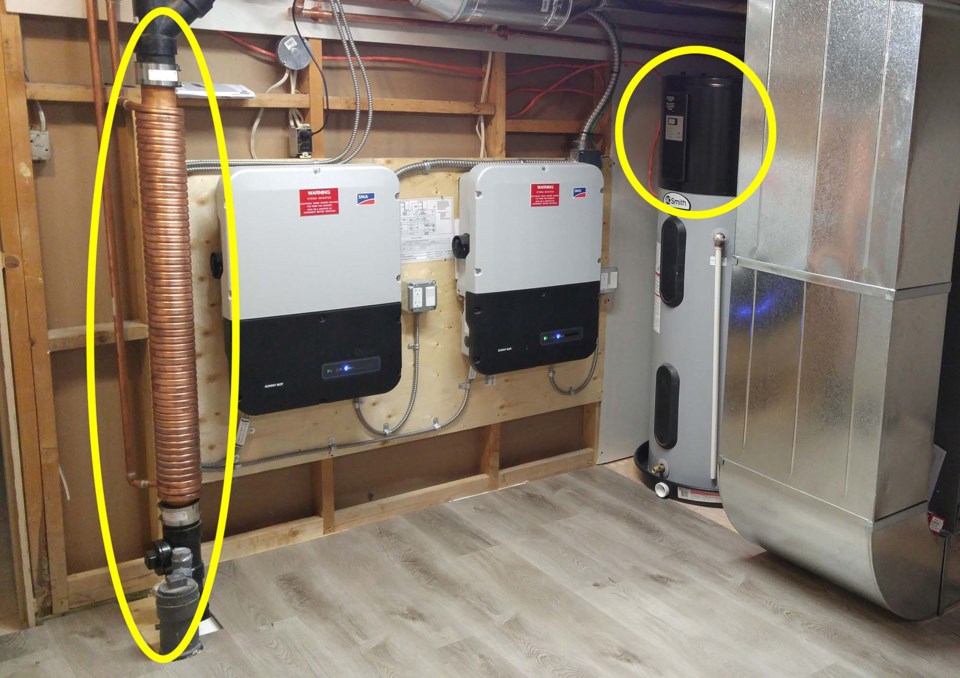This Green House
The Gazette is taking a close look at green retrofits you can fund with St. Albert’s Clean Energy Improvement Program (CEIP). Got a question about retrofits? Email them to [email protected]
If you looked out the window this week, you might have seen huge plumes of steam billowing from your local sewer grate.
That’s not the Ninja Turtles making pizza — that’s heat from your wastewater.
Drain water heat recovery units can help you recoup some of that lost heat. Jesse Tufts, an engineer with ReNü Engineering, has one of them in his net-zero home.
“It should be code, standard,” he said of these units, adding that they were mandatory in homes under Ontario’s building code.
“It makes a big difference.”
Hot water is the second biggest energy user in a Canadian home after space heating, accounting for 17.2 per cent of energy use, reports Natural Resources Canada. If you want a green, money-saving house, you’ll need to have carbon-free water heating, and you can get that with municipal and federal supports.
Stop the drain
“Whenever you’re showering, all that water going down the drain still has a lot of heat in it,” Tufts said, which contributes to those steamy sewers on cold days.
Drain water heat recovery units snatch that heat back before it goes to waste, Tufts explained. These units are big copper pipes with a copper coil wrapped around them, and replace part of your home’s drain stack. The pipe contains outbound wastewater, and the coil has inbound freshwater. The unit conducts heat from the wastewater to the freshwater so the freshwater arrives in your hot water tank pre-heated. Tufts said most units will recover 30 to 50 per cent of your wastewater heat, effectively doubling the size of your hot water tank.
St. Albert offers $150 Home Energy Efficiency Grants for drain water heat recovery units, and also allows them to be funded through CEIP.
Tufts said drain water heat recovery is a no-brainer upgrade that everyone should install if they can get at their drain stack. Home Depot sells the systems for $500 to $900, and you can install them yourself.
Based on ReNü Engineering’s modelling, Tufts said the average four-person household uses about 38 GJ of natural gas a year for water heating. This suggests that a typical drain water heat recovery unit could save a St. Albert family of four about $123/year on gas, assuming a five-year gas-only fixed rate contract with ATCOenergy, and prevent some 0.6 tonnes of greenhouse gas emissions a year. Add in that $150 grant, and that family would recoup the cost of the unit in three-to-six years.
Replace that gas
Drain water heat recovery reduces, but doesn’t eliminate, your natural gas use. To get to net-zero, you’ll need to get off gas and heat your water with green electricity. That means putting in a new water heater.
The simplest alternative to gas is an electric heater, which is what Andrew Mills, president of the Eco-Solar Home Tour Society of Alberta, said he went with for his net-zero home.
“It’s as simple as it gets,” he said, and he uses so little hot water that it’s enough for his needs.
But electricity is more expensive than gas, so electric heating can cost a bundle.
Heat pumps come to the rescue once again here. Tufts said heat pumps cost more up front — about $2,600 for an air-source model, compared to $1,000 for an electric heater — but use two to three times less energy than electric, which makes them less expensive in the long run.
Air-source heat pumps for water look like little round black units on top of a water tank, Mills said. They can be a bit slower than a natural gas heater, but they provide free cooling for your utility room, as they pull their heat from the air. Mills said one guy on last year’s Eco-Solar tour used his air-source water heater to chill his whisky collection.
Mills said ground-source heat pumps can heat your water, but they cost about $24,000 today, not including drilling costs. Solar thermal heaters have fallen out of favour in Edmonton due to their high cost ($6,000 to $8,000) and complexity, and few companies around here offer them anymore.
Heat-pump water heaters are eligible for CEIP financing in St. Albert and a $1,000 Canada Greener Homes grant.
Tuft estimated that a family of four would need 3,300 kWh/year to heat their water using an air-source heat pump. A St. Albert family of that size would spend $705 on water heating under a 100 per cent green energy fixed rate contract with Encor by Epcor, or about $294 more than they would spend if they used gas. They would also prevent about two tonnes of greenhouse gas emissions a year.
But heat pumps can provide space and water heating, allowing you to ditch your gas line and the fixed costs attached to it, Tufts noted. If our family of four got all its heat from heat pumps, it would save $374 a year on water heating, or $585 if they also put in drain water heat recovery.
The Ninja Turtles don’t need your hot water. Use drain water heat recovery and heat pumps to keep your showers warm and your wallets fat.
Green Actions
Action: install drain water heat recovery unit
Cost: $500 to $900 at Home Depot
Payback: 3-6 years with rebate
Savings: $123 and 0.6 tonnes CO2/year
St. Albert rebate: $150
CEIP eligible: yes



